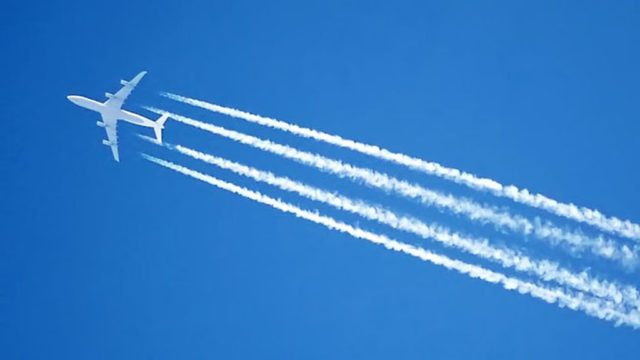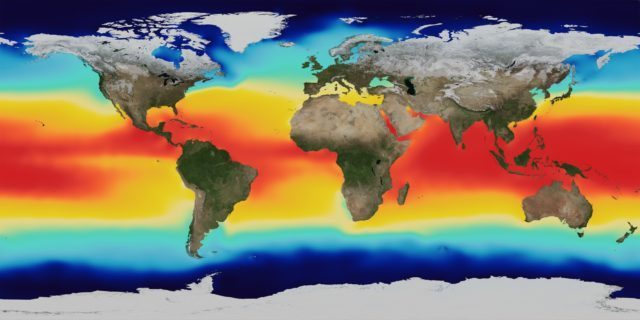Airplanes, with their noise, their consumption of huge amounts of fuel and their emissions, are one of the human creations that most alter the environment. Now a study offers data on another of its disturbances: wakes in the sky. The work highlights that they are having an impact on the climate greater than the greenhouse gases that come out of the turbines of the devices. The worst thing is that, according to his calculations, the heating caused by these artificial clouds will have tripled in 2050.
These contrails of condensation, known in the field of atmospheric science as contrails (not to be confused with the conspiranoic chemtrails), are formed after the passing of airplanes. Through the complex interaction between particles emitted by the engines and the air, the humidity of this condenses forming these clouds. Aircraft generally fly at an altitude, in the upper part of the troposphere, where that humidity is in the form of ice crystals. As the plane passes, they clump around the carbon particles and go directly to the gaseous state. Artificial cirrus clouds are indistinguishable from natural ones.

Now, a pair of atmospheric physics of the German Aerospace Center (DLR, for its acronym in German) has estimated the impact on the climate of these stelae at the current time and for 2050. The work, published in the specialized journal Atmospheric Chemistry and Physics, concludes that these clouds contribute to climate change more than the greenhouse gases (GHGs) emitted by the engines of the devices and that their contribution to global warming will triple by 2050 compared to 2006, the year they use as a starting point for their study.
“The contribution of the contrails to the current climate is slightly higher than that of all CO2 emissions accumulated since the beginning of aviation”, says the researcher at the Institute of Atmospheric Physics of the DLR and co-author of the Lisa Bock study. To get an idea of the relevance of these clouds, Bock recalls that “aviation contributes 5% of the anthropogenic radiative forcing”. That is, in the difference between the amount of solar radiation received by the planet and what it returns to space by human actions, aircraft are responsible for that percentage. And, between 40% and 45% of the total is due to the artificial cirrus clouds that form in its path.
Bock and his colleague and co-author Ulrike Burkhardt estimate that the radiative (or climatic) forcing of aircraft contrails will be 3 times higher in 2050. According to their numbers, in 2006, their impact on global warming was 49 milliwatts per square meter (mW m2). In 3 decades, it will have risen to 159 mW m2. This increase will be much greater than the impact of CO2. Although there are estimates that aviation GHGs could continue to rise, all actors, from scientists to engineers, through industry and politicians, are working to make aircraft engines more efficient and increasingly low in emissions… But after each plane, however efficient, there will still be stelae. And according to data collected by the European Commission, air traffic will have tripled and up to 7 times in 2050.
Artificial cirrus clouds, which start out being compact and rectilinear, expand until they blend with the natural ones. They are of short duration; they disappear around 17 hours after the ice crystals were crowded around some of the soot particles. A previous study estimated that 0.61% of the sky is covered by contrails. The percentage goes up as the focus approaches the regions with the highest air traffic. Thus, on average, 2% of European skies are covered by aircraft contrails, a figure that rises to 10% over the eastern United States or central Europe. The current study indicates that these regions, plus eastern and southern Asia, will have more air traffic, more anthropogenic clouds and, therefore, greater radiative forcing.
The atmospheric physicist of the Metropolitan University of Manchester (United Kingdom) Rubén de León remembers that, unlike water vapor, which efficiently absorbs the heat of the planet but not the sunlight, “the wakes of ice are also efficient in absorbing the heat of the planet and although they manage to reflect the light of the sun they allow the passage of great part”. Here lies its relevance for warming: they trap the outgoing heat and let the incoming pass. “A cirrus-covered sky does not usually produce a sensation of darkness, unlike clouds of liquid water”, adds this expert in the interaction between radiation and cloud ice.
“These stelae have so far caused more warming than the CO2 emitted by the same plane”, says William Collins, professor of meteorology at the University of Reading (United Kingdom). But there is a fundamental difference between both heaters: “Wakes last a short time in the sky while CO2 persists for centuries, so if we are able to reduce air traffic or reduce the wakes it produces, the climate benefit will appear quickly”, adds Collins. With greenhouse gases, the thing will not be so simple.

However, the final impact on global warming is not entirely clear, since there are other factors that enter into the equation. Researchers from the US National Center for Atmospheric Research (NCAR) Chih-Chieh Chen and Andrew Gettelman published in 2016 a paper in which they pointed out that, as global warming increases on Earth, the atmospheric layer where they develop the cirri, both natural and artificial, will narrow, complicating the formation, extension, depth, and duration of the stelae.
In addition, there is another phenomenon that must be taken into account in the total sum: by monopolizing the humidity or the available ice crystals, artificial clouds will reduce the formation of natural clouds. “In the first instance, air traffic can generate trails before the conditions are conducive to the natural formation of cirrus clouds, and secondly, it is possible that the aerosols generated by air traffic do not generate a wake immediately, but that the characteristics of the cirrus clouds that form naturally are modified in the concentration and geometry of the ice crystals”, says De León, who has not participated in this study. And we do not know yet what impact all this will have.

